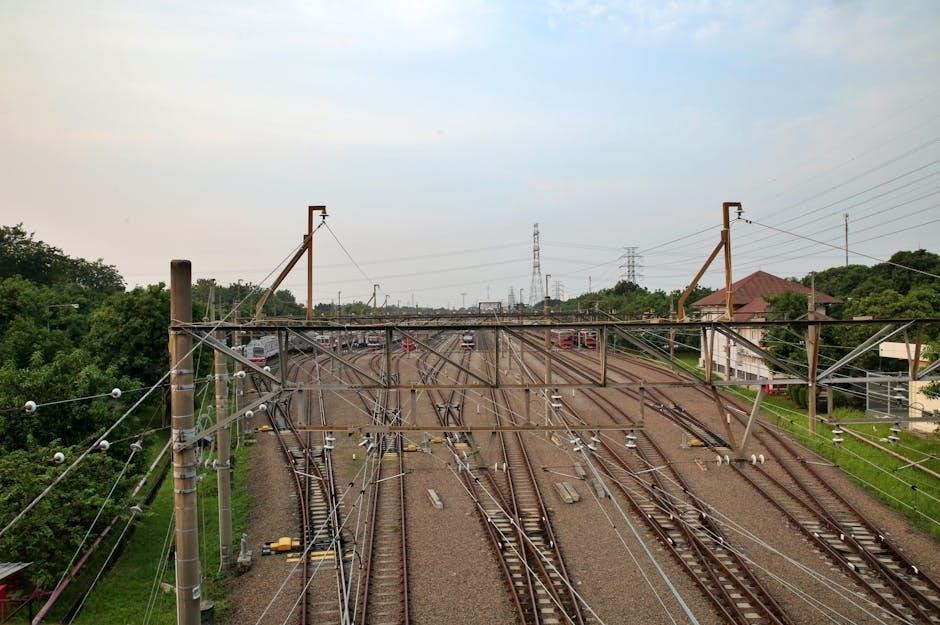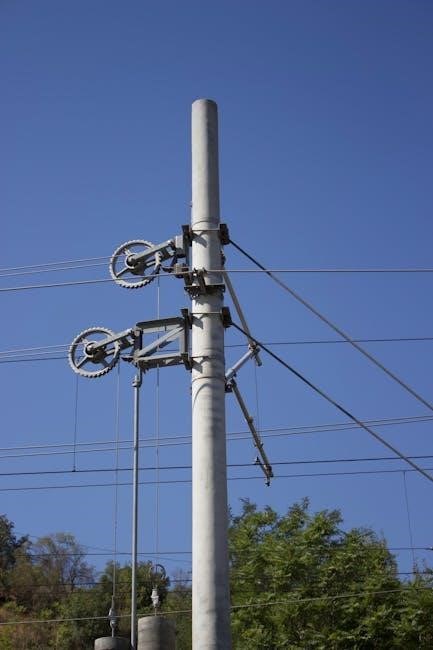The OmniLogic system is a cutting-edge automation solution designed for advanced pool and water feature management. It integrates seamlessly with hardwired networks‚ ensuring reliable and secure connectivity for optimal performance.
1;1 Overview of OmniLogic System
The OmniLogic system is a comprehensive automation solution designed for pool and water feature management. It offers advanced control over pool automation‚ chlorination‚ and integration with smart devices. With a focus on network connectivity‚ OmniLogic supports both hardwired and Wi-Fi configurations‚ ensuring reliable performance. The system is equipped with a user-friendly touchscreen interface‚ enabling seamless monitoring and adjustments. Its network capabilities allow for remote access and real-time monitoring‚ enhancing convenience for users. The OmniLogic system also integrates with additional pool automation systems‚ providing a centralized control platform. By leveraging a hardwired network‚ OmniLogic ensures stable and secure communication between devices‚ minimizing connectivity issues. This system is ideal for homeowners seeking a modern‚ efficient‚ and integrated solution for their pool and water features. Regular updates and maintenance ensure optimal functionality and security.
1.2 Importance of Hardwired Network in OmniLogic
A hardwired network is essential for the OmniLogic system‚ ensuring reliable and high-speed communication between devices. It provides a stable connection‚ minimizing signal loss and interference‚ which is critical for real-time monitoring and control. The hardwired setup supports advanced features like remote access‚ integration with automation systems‚ and seamless updates. Unlike Wi-Fi‚ a physical Ethernet connection offers enhanced security‚ reducing the risk of unauthorized access. This is particularly important for systems managing sensitive pool automation and chlorination processes. A hardwired network also ensures consistent performance‚ even in environments with high wireless interference. By prioritizing a wired connection‚ OmniLogic delivers a robust and dependable solution for homeowners and professionals alike‚ ensuring optimal functionality and peace of mind. Regular troubleshooting steps‚ such as verifying Ethernet connections‚ further emphasize the importance of a stable network setup.
Hardware Requirements for OmniLogic Network
The OmniLogic network requires a reliable Ethernet connection‚ a compatible router‚ and essential hardware components like MSP and network cables for stable and efficient operation.
2.1 Essential Components for Setup

Setting up the OmniLogic system requires specific hardware components to ensure a smooth and reliable connection. First‚ an Ethernet cable is necessary to connect the system to your router or network hub. This cable provides a direct‚ hardwired link‚ which is crucial for maintaining consistent connectivity. Additionally‚ a compatible router is essential to manage data transmission and ensure that all components communicate effectively. The system also relies on a power supply unit to maintain operation. Furthermore‚ a touchscreen interface or control panel is needed for user interaction and configuration.,OmniLogic,。
2.2 Compatibility with Hardwired Connections
OmniLogic systems are designed to work seamlessly with hardwired networks‚ ensuring stable and high-speed connectivity. The system supports Ethernet cables‚ which provide a direct and reliable link to your router or network hub. This compatibility allows for minimal latency and maximum performance‚ crucial for real-time automation and monitoring. The OmniLogic system is also compatible with standard network protocols‚ making it easy to integrate with existing infrastructure. Hardwired connections eliminate interference issues common with wireless networks‚ ensuring uninterrupted operation. By using a wired setup‚ users can maintain optimal performance and security for their pool automation and chlorination systems. Regular firmware updates further enhance compatibility‚ ensuring the system remains efficient and secure over time.

Installation and Setup Guide
The OmniLogic system requires connecting hardware‚ configuring network settings‚ and ensuring all cables are securely plugged in. Follow the manual for a smooth setup process.

3.1 Step-by-Step Installation Process
To install the OmniLogic system with a hardwired network‚ start by connecting the hardware components; Ensure the Ethernet cable is securely plugged into both the MSP and the router. Verify the connection by checking the lights on the Ethernet ports. Next‚ power on the OmniLogic system and wait for it to initialize. Use a computer or mobile device to access the setup interface through the network. Follow the on-screen instructions to configure basic settings‚ such as assigning an IP address and setting up a username and password. Once connected‚ test the network by pinging the OmniLogic system or accessing its web interface. If issues arise‚ refer to the troubleshooting section or the provided manual for guidance. Complete the setup by enabling additional features like remote access or integration with other systems. Ensure all firmware updates are installed for optimal performance.
3.2 Configuring the Hardwired Network
Configuring the hardwired network for OmniLogic involves setting up the network parameters to ensure seamless communication between devices. Begin by connecting all hardware components‚ such as sensors and control panels‚ to the central hub using Ethernet cables. Assign static IP addresses to each device within the same subnet to maintain consistency. Configure the subnet mask‚ default gateway‚ and DNS settings to match your network architecture. Enable VLANs if necessary to segregate traffic and enhance security. Test the configuration by pinging devices or checking connectivity through the OmniLogic interface. If issues arise‚ verify cable connections and IP assignments. Ensure all devices are synchronized with the central controller for proper functionality. Finally‚ document the network setup for future reference and troubleshooting purposes. Proper configuration ensures reliable performance and optimal integration of the OmniLogic system with your hardwired network infrastructure.

Network Configuration
Network configuration involves setting up the OmniLogic system to ensure reliable communication between devices. Properly configure IP addresses‚ subnet masks‚ and gateways for seamless connectivity.
4.1 Setting Up Network Parameters
Setting up network parameters is crucial for ensuring the OmniLogic system operates efficiently. Begin by accessing the system’s web interface through a connected device. Navigate to the network settings section and input the necessary parameters‚ such as IP addresses‚ subnet masks‚ and default gateways. These settings must align with your local network configuration to maintain connectivity. Assign static IP addresses to critical devices to prevent conflicts and ensure consistent communication. Configure subnet masks to define the scope of your network‚ and set default gateways to enable routing between devices. Additionally‚ specify DNS server addresses for proper domain name resolution. After configuring‚ test the connection by pinging devices within the network to verify stability. Properly documenting these settings ensures easy troubleshooting and future updates. Always refer to the OmniLogic manual for specific guidelines tailored to your system.
4.2 Assigning IP Addresses Manually
Assigning IP addresses manually is essential for devices requiring static connections in the OmniLogic network. Begin by accessing the device’s network settings through its web interface or control panel. Enter the static IP address‚ ensuring it falls within the defined subnet range to avoid conflicts. Specify the subnet mask‚ default gateway‚ and DNS server addresses accurately. Documenting these IP assignments is crucial for maintaining network organization and simplifying future configurations. Avoid overlapping IP addresses‚ as this can cause connectivity issues. After assigning‚ restart the device to apply the changes. Use the OmniLogic manual to identify the correct IP range for your system. Regularly review IP assignments to ensure they remain consistent with your network architecture. This process ensures reliable communication among all devices in the OmniLogic ecosystem. Always double-check entries to prevent human error‚ which can disrupt network functionality.
4.3 Configuring Wi-Fi Bridge for OmniLogic

Configuring a Wi-Fi bridge for the OmniLogic system enhances connectivity by linking wireless devices to the hardwired network. Begin by enabling the bridge mode on the Wi-Fi device and connecting it to the OmniLogic network. Ensure the bridge supports the same wireless standards (e.g.‚ 802.11ac) as your OmniLogic system for optimal performance. Configure the bridge’s IP address to align with your network’s subnet‚ typically within the same range as other devices. Use the OmniLogic interface to assign the bridge a static IP or enable DHCP for automatic assignment. Secure the connection by setting a strong password and enabling WPA3 encryption. Test the bridge by connecting a device wirelessly and verifying its ability to communicate with the OmniLogic system. Regularly update the bridge’s firmware to maintain compatibility and security. Refer to the OmniLogic manual for specific configuration steps tailored to your setup.

Troubleshooting Common Issues
Troubleshooting common issues in the OmniLogic hardwired network involves checking connections‚ verifying configurations‚ and restarting devices. Identify and resolve faults promptly to ensure reliable system performance.
5.1 Identifying Ethernet Connection Problems
Identifying Ethernet connection issues in the OmniLogic system begins with checking physical connections. Ensure all cables are securely plugged into the correct ports and free from damage. Verify that Ethernet cables are not bent‚ crushed‚ or damaged‚ as this can disrupt connectivity. Check for loose connections at both the device and network switch ends. If using a crossover or straight-through cable‚ confirm it is the correct type for the connection. Use the OmniLogic manual to locate diagnostic LEDs on Ethernet ports‚ which often indicate link status and activity. If the LED is off or blinking erratically‚ it may signal a hardware issue or misconfiguration. Additionally‚ review network configuration settings to ensure IP addresses and subnet masks are correctly assigned. Power cycle switches or routers and restart connected devices to reset the connection; If issues persist‚ consult the OmniLogic manual for specific troubleshooting steps tailored to your system.
5.2 Resolving Network Connectivity Errors
Resolving network connectivity errors in the OmniLogic system involves a systematic approach to identify and address potential issues. Start by verifying the physical connections‚ ensuring all Ethernet cables are securely attached to the correct ports. Check for any signs of damage or wear on the cables and replace them if necessary. Use a network cable tester to confirm the integrity of the Ethernet connections. If issues persist‚ restart the network devices‚ including routers and switches‚ to reset the connections. Review the network configuration settings to ensure IP addresses‚ subnet masks‚ and default gateways are correctly assigned. consult the OmniLogic manual for guidance on resetting the system to factory settings if needed. Additionally‚ update the firmware of network devices to resolve any compatibility issues. If connectivity problems remain unresolved‚ contact OmniLogic support for further assistance.

Security Considerations
OmniLogic systems prioritize security through robust encryption protocols and secure access controls. Regular firmware updates and physical protection of hardware are essential to maintain network integrity and safeguard data.
6.1 Best Practices for Network Security
To ensure a secure OmniLogic hardwired network‚ implement strong passwords and restrict access to authorized personnel only. Enable firewall settings and regularly update firmware to patch vulnerabilities. Use encrypted communication protocols for data transmission and disable unnecessary ports to minimize exposure. Conduct periodic network audits to detect unauthorized devices or suspicious activity. Physically secure hardware in tamper-proof locations to prevent unauthorized access. Implement role-based access control to limit user privileges based on responsibility. Monitor network traffic for unusual patterns and maintain a backup of critical configurations. Document all security measures and update policies as threats evolve. By following these practices‚ you can significantly enhance the resilience of your OmniLogic network against potential breaches and cyber threats.
6.2 Implementing Encryption Protocols
Encrypting data is crucial for safeguarding sensitive information on the OmniLogic hardwired network. Use industry-standard encryption protocols such as AES (Advanced Encryption Standard) or TLS (Transport Layer Security) to protect data both at rest and in transit. Enable SSL/TLS for secure communication between devices and ensure all firmware updates are encrypted. For wireless segments‚ WPA3 encryption is recommended to maintain integrity. Regularly review and update encryption keys to mitigate risks. OmniLogic systems support robust encryption‚ ensuring compliance with security standards. By implementing these protocols‚ you can safeguard your network from unauthorized access and data breaches‚ maintaining confidentiality and integrity of all transmitted information.

Maintenance and Updates
Regular maintenance ensures the OmniLogic system operates efficiently. Schedule thorough checks for hardware and software updates to maintain optimal performance and security.
7.1 Regular System Maintenance Tips
Regular system maintenance is crucial for ensuring the OmniLogic network operates smoothly. Start by inspecting all physical connections and cables for damage or loose links‚ as these can disrupt data transmission. Use diagnostic tools to monitor network performance and identify potential bottlenecks. Logs and event viewers can help detect issues before they escalate. Perform routine power cycling of devices to clear cached data and reset connections. Additionally‚ ensure all hardware components are free from dust and debris‚ which can impair functionality. Schedule periodic checks of IP configurations to prevent conflicts. Finally‚ maintain a backup of network settings to restore quickly in case of failures. By following these tips‚ you can maintain a stable and efficient OmniLogic hardwired network.
7.2 Updating Firmware for Optimal Performance
Updating the firmware of your OmniLogic system is essential for ensuring optimal performance and security. Begin by checking the manufacturer’s website for the latest firmware version compatible with your hardware. Download the update and carefully follow the installation instructions provided. It’s crucial to avoid interrupting the update process‚ as this could cause system instability. After installation‚ restart the network devices to apply the changes. Regularly updating firmware ensures you benefit from performance improvements‚ bug fixes‚ and enhanced security features. Additionally‚ firmware updates may introduce new functionalities or compatibility enhancements. Always verify the authenticity of firmware files to prevent potential security risks. By keeping your OmniLogic system up to date‚ you ensure a reliable and high-performing hardwired network environment.

Advanced Features and Integration
The OmniLogic system offers advanced integration with pool automation‚ enabling seamless control and remote access. It also supports smart device connectivity for enhanced functionality and efficiency.
8.1 Enabling Remote Access
Enabling remote access for the OmniLogic system allows users to manage their network and connected devices from anywhere; This feature is particularly useful for monitoring and controlling pool automation systems remotely. To set up remote access‚ ensure your hardwired network is configured with a static IP address for stability. Use encryption protocols like SSL/TLS to secure remote connections and protect data integrity. Additionally‚ enable port forwarding on your router to direct remote access requests to the OmniLogic hub. For enhanced convenience‚ integrate with mobile apps or third-party software that supports remote monitoring and control. Always verify that the remote access setup aligns with your network’s security policies to prevent unauthorized access. Regularly update firmware and security settings to maintain robust protection for remote connections. This feature ensures seamless management of your OmniLogic system‚ even when you’re not physically present.
8.2 Integrating with Pool Automation Systems
Integrating the OmniLogic system with pool automation systems enhances control and efficiency. The hardwired network ensures reliable communication between the OmniLogic controller and pool devices like pumps‚ heaters‚ and lighting. By connecting these systems‚ users can synchronize operations‚ such as adjusting pool temperatures or lighting settings‚ directly through the OmniLogic interface. This integration streamlines management‚ reducing the need for multiple control points; For seamless connectivity‚ ensure the pool automation system is compatible with the OmniLogic controller and configure the necessary communication protocols. Regularly update the system firmware to maintain compatibility and performance. This integration allows for advanced automation scenarios‚ improving overall pool management and user experience. It also enables remote monitoring and control‚ ensuring optimal pool conditions at all times.
The OmniLogic system offers a reliable‚ scalable‚ and efficient solution for hardwired network needs. Future updates will focus on enhanced AI integration and smarter automation capabilities.
9.1 Summary of Key Points
The OmniLogic system provides a robust and reliable hardwired network solution‚ ensuring optimal performance and scalability for various applications. Key components include essential hardware‚ such as routers and switches‚ and proper network configuration to maintain stability. Security practices‚ like encryption and regular updates‚ are critical to safeguarding the system. Troubleshooting common issues‚ such as Ethernet connectivity problems‚ ensures minimal downtime. Regular maintenance and firmware updates are vital for sustained performance and security. The system’s compatibility with hardwired connections ensures a stable and fast network environment. By following the installation and configuration guidelines‚ users can maximize the potential of their OmniLogic network. Future advancements in network technology promise even greater efficiency and integration capabilities.
9.2 Future Trends in Network Technology
Emerging trends in network technology promise to revolutionize the OmniLogic system’s capabilities. Advancements in AI-driven network optimization will enable smarter traffic management and predictive maintenance. The integration of IoT devices will expand connectivity‚ while 5G networks will enhance speed and reliability. Quantum computing could usher in unprecedented data processing power‚ improving encryption and security. Edge computing will reduce latency by processing data closer to the source. Additionally‚ advancements in Ethernet standards‚ such as faster speeds and improved energy efficiency‚ will bolster hardwired networks. These innovations will ensure OmniLogic remains at the forefront of network technology‚ offering enhanced performance‚ scalability‚ and security for future applications.
